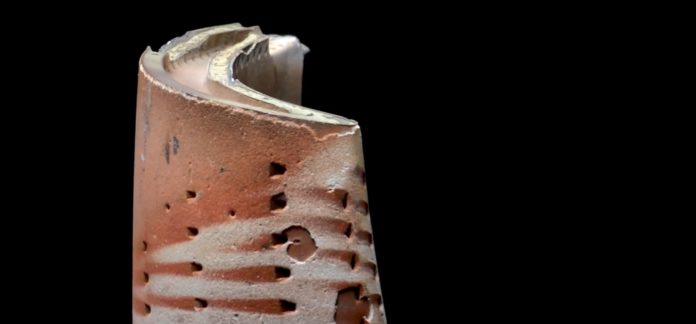As an early adopter of additive manufacturing technologies, one of the first applications Siemens Energy highlighted was the ability to repair turbines and manufacture components using its digital twin technology. Today, the company shares that by implementing cooling structures in critical areas to prevent blade tip failure, they are not just repairing the turbine blades, they also improve them.
As the company explains, a single turbine blade of an SGT5-4000F gas turbine converts about as much power into rotational energy as 10 Porsche 911s. Due to the high temperatures coupled with the high gas velocities during operation of a gas turbine, burn-off at the blade tip can occur, ultimately leading to gap formation and a measurable drop in the performance of the entire turbine. This process leads to a vicious circle: with greater gap formation, the temperature of the blade material increases due to the overflowing hot gas, which in turn leads to even faster material loss and further increases the gap between blade tip and ring segment.
By using Laser Powder Bed Fusion (L-PBF) metal printing for production, the engineering team at Siemens Energy can produce structures with inner channels in high resolution. This high resolution is important to incorporate the new cooling geometries with a very limited cross-section. With this new design, the critical areas can be cooled more effectively, thus preventing material loss.
Blades that have been in operation at high temperatures have individual shapes, making the L-PBF repair more challenging. Therefore, a new CAD-CAM chain has been implemented in order to automatically adapt the shape of the L-PBF tip so that it perfectly matches each blade. By combining 3D scanning technologies and an algorithm developed by the Siemens Energy team, a digital repair chain was established that can morph the geometry parametrically. The team also had to develop the L-PBF process for an extremely oxidation-resistant material for the blade tip.
The application of this technology to existing components is still a rather unexplored marginal area of 3D printing technology, also known as Hybrid L-PBF Repair (short: HybridTech). Fact is: This innovation offers direct customer benefits through the constant power output of the respective gas turbine.
The first blade sets have already been manufactured and a conversion of the standard repair procedure to the new process is underway. The technology is to be applied to other components in the future and even completely new component designs can be upgraded with it.
Remember, you can post free of charge job opportunities in the AM Industry on 3D ADEPT Media or look for a job via our job board. Make sure to follow us on our social networks and subscribe to our weekly newsletter : Facebook, Twitter, LinkedIn & Instagram ! If you want to be featured in the next issue of our digital magazine or if you hear a story that needs to be heard, make sure to send it to contact@3dadept.com






